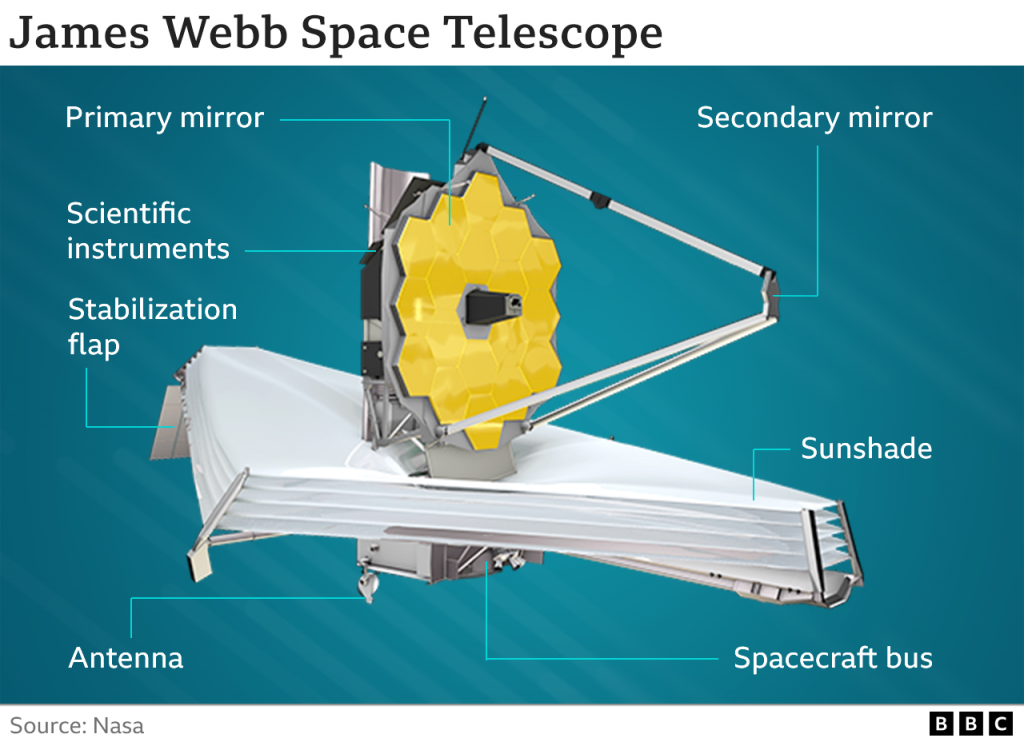After multiple setbacks, the telescope is back on track
After near 30 years of planning and thorough work, NASA finally launched its long-awaited $10 billion next-gen space observatory, the James Webb Space Telescope on December 25. Following its launch, the telescope has started unfurling into its final shape.
Since they were massive at more than 21 feet (6.5 m) across, the telescope’s sunshield and primary mirror had to be folded to fit into the European Ariane rocket it launched on. And the riskiest part of the process was the tightening of that massive sunshade.
While the operation was initially smooth sailing, the team behind James Webb Space Telescope encountered some problems during the deployment of the sunshade. Even though Hubble’s successor was never really in grave danger owing to its constant power flow, the deployment was considered to be the project’s most challenging hurdle. First, the flight controllers in Maryland had to reset Webb’s solar panel to draw more power, then they also had to repoint the telescope to prevent any kind of overheating on its motors by limiting sunlight.
After the motors were cooled down and it was safe to continue, the team re-started a three-day process of stretching the tennis court-sized sunshield on the James Webb Space Telescope. According to the officials, it is now in the process of being fully stretched and should be ready by Wednesday, January 5.
What makes the sunshield so crucial for the telescope is its ability to cool down James Webb Space Telescope’s enormous mirror and infrared instruments to nearly 400 degrees below zero and block out the heat of the sun while they explore the universe and the atmospheres of alien worlds for possible signs of life.
If all goes according to plan, Webb should be able to reach its final destination of 1 million miles (1.6 million kilometers) away from the earth by the end of this month. As of January 3, the telescope is already halfway there. By the end of June, the massive observatory should begin exploring the universe, hopefully unveiling the mysteries behind the very first stars and galaxies formed in the universe 13.7 billion years ago.

Features
The James Webb Space Telescope has a mass about half of Hubble Space Telescope‘s, but a 6.5 m (21 ft)-diameter gold-coated beryllium primary mirror made of 18 hexagonal mirrors, giving it a total size over six times as large as Hubble’s 2.4 m (7 ft 10 in). Of this, 0.9 m2 (9.7 sq ft) is obscured by the secondary support struts, making its actual light collecting area about 5.6 times larger than Hubble’s 4.525 m (14.85 ft) collecting area.
JWST is designed primarily for near-infrared astronomy, but can also see orange and red visible light, as well as the mid-infrared region, depending on the instrument. The design emphasizes the near to mid-infrared for three main reasons:
high-redshift objects have their visible emissions shifted into the infrared cold objects such as debris disks and planets emit most strongly in the infrared this band is difficult to study from the ground or by existing space telescopes such as Hubble Ground-based telescopes must look through Earth’s atmosphere, which is opaque in many infrared bands (see figure of atmospheric absorption). Even where the atmosphere is transparent, many of the target chemical compounds, such as water, carbon dioxide, and methane, also exist in the Earth’s atmosphere, vastly complicating analysis. Existing space telescopes such as Hubble cannot study these bands since their mirrors are insufficiently cool (the Hubble mirror is maintained at about 15 °C (288 K; 59 °F)) thus the telescope itself radiates strongly in the infrared bands.[37]
JWST will operate in a halo orbit around the Sun-Earth L2 (Lagrange point), approximately 1,500,000 km (930,000 mi) beyond Earth’s orbit around the Sun. By way of comparison, Hubble orbits 550 km (340 mi) above Earth’s surface, and the Moon is roughly 400,000 km (250,000 mi) from Earth. This distance probably makes it impossible for a crewed mission to repair or upgrade the observatory in the future, as was done for Hubble. During the long JWST testing period, NASA officials referred to the idea of a servicing mission, but no plans were announced.[39][40]
Objects near this Sun-Earth L2 point can orbit the Sun in synchrony with the Earth, allowing the telescope to remain at a roughly constant distance with continuous orientation of its unique sunshield and equipment bus toward the Sun, Earth and Moon to simultaneously block heat and light from all of these, and also to maintain communications. This arrangement will keep the temperature of the spacecraft below the 50 K (−223 °C; −370 °F) necessary for faint infrared observations.
